Airbrush II - Hoses and Adapters
18 November 2013 00:14 Filed in: Tools
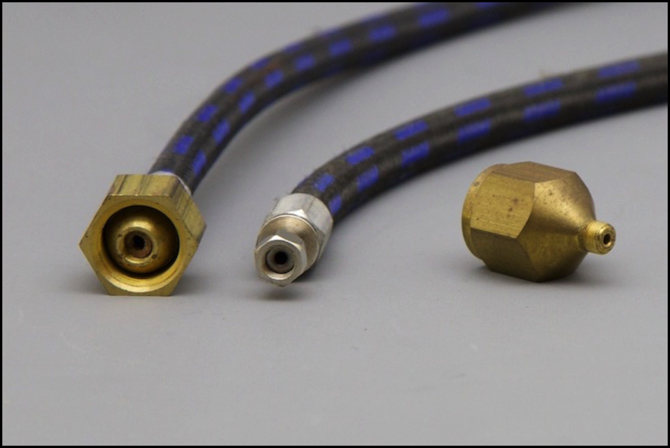
Badger Airbrush Hose: L-to-R compressor end, airbrush end, compressor adapter for small hoses
The first airbrush was patented in 1876. You’d think after 137 years people would have figured out one “right” way to hook one up to an air supply. Alas, “people” are never that sensible.
In the course of researching airbrushes, I bumped up against the fact that there are a number of different methods for connecting airbrushes to compressors, using different sizes of connectors and incompatible connectors of the same size. Some of these are multi-vendor, some appear to be unique to a single vendor. Most appear to derive from national standards from wherever the airbrush is made, or marketed.
And they’re not well documented: you’ll run across terms like “Badger adapter”, but adapter from what? I decided I needed to figure out just what was in use. This plethora of connectors apparently wouldn’t keep me from mixing any airbrush with any compressor, but to do that was going to require knowing what kinds of hoses or adapters would be needed. Plus, thinking about this gave me more time to let the question of “which compressor and which airbrush” bounce around in the back of my head.
So yeah, we’re continuing our break from model railroading to talk about airbrushes again, and likely will next week as well since I still need to talk about the actual airbrushes. But today’s topic is the mundane yet complex arcana of airbrush hoses and fittings.
And since I’ve collected a lot of raw info on airbrushes I might want to reference in the future, or someone else might find useful, I’ve created a set of Airbrush pages in the Tools section. While these Musings won’t be updated, any new info I learn will go into those pages to keep them up to date. There’s now a Hoses page, along with a page on pipe Standards, collecting my most recent notes.
Airbrush Hoses
The basis of an airbrush is that it uses compressed air to propel paint at whatever is being painted. That air comes from a tank or compressor, and gets to the airbrush via a hose. Hoses come in a variety of lengths, although 10’ (3m) is a common size, and in two main forms: smooth vinyl or polyurethane tubing (which can be straight or coiled) and rubber or similar hoses with a braided nylon cloth jacket. Costs run around US$10 to US$20 depending on material, with some premium brands fetching higher prices. And adapters to connect the hoses to things can add US$5 to US$20 to the total cost.
The smooth tubing hoses are generally lighter, while the ones with a braided jacket are made of more robust materials that will stand up to lots of bending and other heavy use, but you pay for that in a bulkier hose connected to the airbrush you hold in your hand. I’m definitely a fan of the heavier hose; having used it on my old airbrush I don’t think I could go back to the tubing.
At each end of the hose is a connector, usually some kind of screw-on fitting with the female end on the hose. One end will be designed to connect to an airbrush, the other to the air source, and these are usually different kinds of connectors. The interior of the hose is typically around 1/8” (3mm) in diameter, although the outside will be larger. The connectors on the ends are usually “1/4-inch” at the compressor, and something close to “1/8 inch” at the airbrush. But if you actually measure them, that “1/4 inch” connector is about 1/2 inch wide. This is another one of those odd historical things, where what we call something doesn’t have very much to do with its modern form: the number refers to the original inside diameter of a pipe, likely an iron pipe from the mid-nineteenth century.
The picture above shows my old Badger hose, with a 1/4” fitting on the left for the compressor end, and a metric M5 fitting on the right for the airbrush end. The separate brass fitting is used to connect their vinyl hose to a compressor, having a 1/4” female end for the compressor and an M5 male end for the hose.
One thing to beware of is that there are multiple standards in use, and a 1/4” connector from one company won’t necessarily mate well with a 1/4” connector from another. Unless you know two companies are using the same thing, trying to make them connect may result in a connection that seals poorly and/or which damages the connectors. If someone makes an adapter for the two, there’s a good reason for it, and you’re best off using it.
After reading up on all the standards, I went out and bought some hoses to compare.
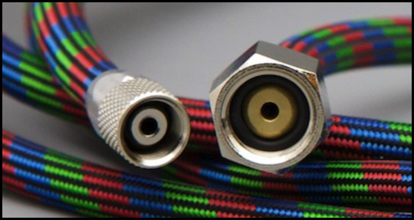
Iwata Hose
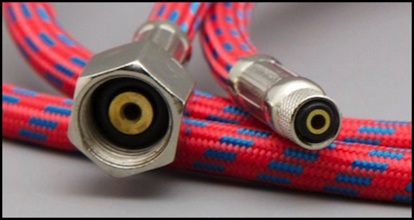
Paasche Hose
The two photos above make the hoses seem very similar, but they’re not. Iwata uses a European standard while Paasche uses an American standard. The two differ in both the shape and number of threads per inch, as well as the depth (the Iwata is only about three turns to tight, the Paasche is about twice that and for a reason. You might actually get a hose in one form to connect to a compressor in the other with some thread-seal Teflon tape and perhaps a bit of force, and it might even work at the low pressures in use by airbrushes. But they’re not the same, and what works now may not still be working in a couple of years.
In fact, although Paasche and Badger both use American standards for their compressors, they don’t actually use the same connector, as you can see by comparing the Paasche and its rubber O-ring with the Badger hose and its tapered internal brass fitting above. It’s not that they omitted the O-ring of the Paasche to be cheap; there’s a real difference in the connectors, and Badger’s follows a standard designed for a metal-on-metal seal. Badger also uses a very different connector on the other end of the hose, having chosen to go metric for that, but not using the same European standard as Iwata (which uses a British pre-metric standard that has a metric equivalent, so the EU can use it without feeling guilty or something).
There’s a lot to know about hoses, but all it really boils down to is a few standards for compressors and a few different ones for airbrushes, it’s just that hoses have to connect both worlds, which gets a bit complicated. But that’s really all there is to hoses: pick hoses that match, or use adapters.
Generally it’s best to use hoses from the same company that sold the compressor, as the other end has a richer set of adapters for connecting airbrushes. Some companies do make hoses that will fit brands other than theirs, and a few do use the same fitting on the compressor end as others, but in general you’ll have fewer problems matching hose to compressor.
And you have to watch out for companies with more than one standard: many years ago I got burned by Badger, which sells hoses with both 1/4” and M5 compressor ends, and you need to buy an adapter to use an M5 hose (which I bought originally) with their own compressor.
I am, however, tempted to look into ways to use other hoses. Both the Paasche and Grex hoses are more flexible than the others I have (Badger and Iwata; I wasn’t able to find any others locally for my comparison). And the Grex hose has a slightly smaller outside diameter, making it easier to work with (although I think the Paasche hose bends more easily). I’m very tempted to find a way to use a Grex hose regardless of what else I do.
At the other end you have two choices: you can screw the hose onto the airbrush, either directly or with an adapter if the two come from different companies. Or you can use a quick-release fitting. There appears to be a standard 2.7mm size for these, so you can even buy the part that goes on the hose from one company and the part that goes on the airbrush from another.
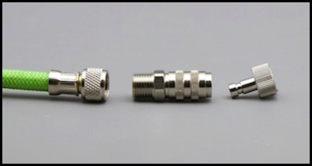
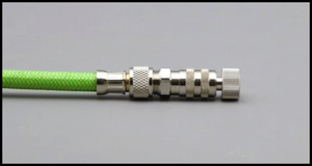
Grex quick-connect apart (left) and together (right)
The photo above shows a quick-release fitting, with the cylindrical part that connects to the hose, and the small T-shaped adapter that connects to the airbrush.
There is a lot more variation in what airbrushes use for their connections, so adapters of one kind or another are likely to be required unless you bought everything from the same or compatible companies.
Note: there are quick release fittings for the compressor end, and some people swear by them. But there’s much less selection, and I don’t see how swapping hoses is any less work at one end than the other. And swapping hoses at the compressor means that you need to buy a hose for each airbrush, which costs more.
Summary
And there we are: I’ll likely end up using a hose compatible with my compressor, once I select a compressor, although depending on the compressor I may use a Grex hose instead. And I expect to use a quick-release fitting on the airbrush end. It took me more than a week of modeling time researching options to come to what may well have been an obvious conclusion, but now it’s a conclusion I can make with a degree of confidence that I will have a working system when I’m done, with no hidden surprises waiting to pounce.



